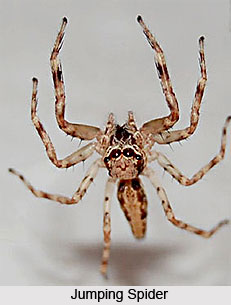 Jumping Spider possesses strong legs, stout body, and medium sized, blackish and decorated with white streaks. All jumping spiders have two prominent anterior median eyes like motor-car-jumps. The males and females are almost of equal size. Jumping spiders are found everywhere - on the tops and trunks of trees, along walls and fences on open ground, on flowers and in hundreds of other places. They like sunshine and rain and thrive in all seasons. There are several ant-mimica among Attids. The males are generally more attractive and ornamented than the females. It is a sight to see the male dancing before his partner before mating.
Jumping Spider possesses strong legs, stout body, and medium sized, blackish and decorated with white streaks. All jumping spiders have two prominent anterior median eyes like motor-car-jumps. The males and females are almost of equal size. Jumping spiders are found everywhere - on the tops and trunks of trees, along walls and fences on open ground, on flowers and in hundreds of other places. They like sunshine and rain and thrive in all seasons. There are several ant-mimica among Attids. The males are generally more attractive and ornamented than the females. It is a sight to see the male dancing before his partner before mating.
The jumping spiders dwell in several habitats. Most of the species live in Tropical forests, but these jumping spiders are also seen in temperate forests, deserts, scrub lands, inter-tidal zones and mountains. One species, Euophrys omnisuperstes, is found in the highest elevation of the Mount Everest slopes. The Jumping spiders are mainly identified with the help of their eye pattern.
These are normally diurnal, active hunters. Their well-formed internal hydraulic system broadens their limbs by changing the body fluid pressure or blood pressure within them. This in turn, helps them to jump even without possessing large muscular legs like a grasshopper. These spiders are capable of jumping 20 to 60 or even seventy five to eighty times the length of their own body. At the time of movement of a jumping spider from place to place, and more specifically before it jumps, the spider tethers a silk filament to whatever over which it is standing on. Should the jumping spider fall for one reason or the other, the spider climbs itself back up the silk tether.
The Jumping spiders are very much active in hinting, and this suggests that they rely very little on a web to get a prey. Even if spiders are normally carnivorous, there are a number of jumping spiders which use pollen and nectar in their diet and one species of Jumping spiders, Bagheera kiplingi, feeds mainly on plant matter. However, there are no known species of Spiders which feed on seeds and fruits.
The male Jumping spiders possess a very beautiful body. The front legs are coloured and have classifiable bands of hair. In several species the male undertakes difficult courtship displays wherein it bobs its body and waves the colourful front legs in a more specific manner. After the mating is over, the female Jumping spider lays her eggs in a silk-lined shelter under bark or stones, or on the plant surface. The female often guards the eggs till it hatches young ones.



















